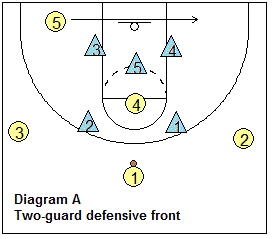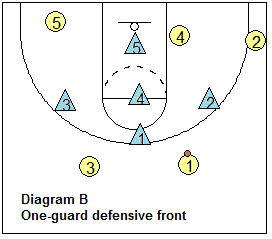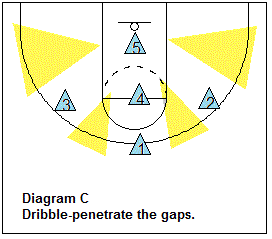Basketball Offense - Zone Offense
By Dr. James Gels, from the Coach’s Clipboard Basketball PlaybookDisclosure: This page contains affiliate links, which means that Coach's Clipboard receives a small commission (at no cost to you) if you make a purchase using these links.
More Reading on Zone Offense
- Key Elements/Principles in Attacking the 2-3 Zone Defense
- Attacking the 2-3 Zone Defense
- Simple, Easy 2-3 Zone Attack
- Kansas 2-3 Zone Offense
- Kansas Zone Plays
- 2-3 Zone Offense Plays
- Screening the Zone
- Delta Zone Offense
- Anchors Zone Offense
- Dribble-Drive Zone Offense
- Notes on the Read and React Zone Offense
- Stanford Motion-Zone Offense
- T-Game Triple-Post Offense
- Attacking the 1-3-1 Zone Defense
- Attacking the 1-2-2 Zone Defense
- Attacking the 3-2 Zone Defense
- 4-Out Zone Offense and Zone Plays
- 5-Out Zone Offense
- Attacking "Junk" Defenses
- Attacking the Box-and-1 Defense
- Attacking the Triangle-and-2 Defense
- Open Post Double-Up Zone Offense
General pointers in attacking any zone defense.
1. Beat the defense up the floor.
If it is your team's offensive style, fast-break and push the ball up the floor as quickly as possible, before the defense can get set.2. Full-court press on defense
This favors a transition type, wide-open, up-tempo game. A slow-down, half-court game allows the zone defense to be more effective.3. Analyze the zone
What kind of zone set are you facing, 2-3, 1-2-2, 1-3-1, etc? Then set your offense accordingly.If the defense shows a two-guard front (e.g. 2-3 zone - diagram A), use a one-guard offense to "split" the two top defenders. Offensive sets to use are: 1-3-1, 1-2-2, 3-out 2-in, or 1-4 offense. See 2-3 Zone Offense.


The opposite applies if the defense shows a one-guard front (e.g. 1-3-1 or 1-2-2 zone). In this case (diagram B), use a two-guard offense to flank the single top defender. Offensive sets to use are: 2-1-2, 2-3, 2-2-1, 4-out 1-in offense.
See 1-2-2 Zone Offense and 1-3-1 Zone Offense.
If the opponent keeps changing its defense, call out your offensive counter from the bench. Some teams change defenses, and you have to be ready, and you can't call a time-out every time.
Fran Fraschilla discusses recognizing zones (from his DVD "AAU Coaching Boys Basketball Series: Zone Offense and Specials":
4. Patience
Be patient on offense, but take the first open, good percentage shot. Make sure your best shooters are getting their shots. It's easy to settle for outside shots against zones. But you still must get the ball inside. We have a rule that (except in transition), before any outside shot goes up, we must have one post touch first (either low or high post).5. Offensive rebounding
Crash the offensive boards as a zone defense often does not have clear-cut box-out assignments, and extra high-percentage shots can be gotten off the offensive rebound.6. Maintain good spacing
Stretch the zone with a pass to a wing or corner, and then skip pass to the opposite side. Don't get bunched up. Players should move into the gaps and passing lanes in the zone (see diagram C). Overload zones by flooding areas of the zone with more offensive players than it can cover.7. Drive and kick. Attack the gaps, but avoid unnecessary dribbling
Unnecessary dribbling allows the defense time to adjust or reset. However, guards and wings should look to dribble-penetrate the gaps in the zone (diagram C), and look to score or pass.
Another good option is the "penetrate and pitch back" - when someone dribble-penetrates, the next perimeter player over rotates into the spot vacated by the dribbler. As the dribbler sucks that perimeter defender inside, he/she can stop, pivot and pass back out to where he/she came from, which will be open for the 3-point shot.
8. You must get the ball inside
Get the ball inside for high-percentage shots. It's OK to take the outside jumper or 3-pointer, but don't settle for the outside shot on every possession (see pointer #4 above). You must get it inside for those important "points in the paint".Having success inside will cause problems for the defense, may result in their getting into foul trouble, and will open up outside shots when the defense collapses inside. If the post player is well-defended, go "inside-out" with a quick pass out for an open 3-pointer.
9. Use crisp passing
And use the skip pass from corner to opposite wing, and wing to opposite corner. Look for the lob pass to the baseline and back-door. Passers should use shot fakes and pass fakes, where they fake a shot or fake a pass to get the zone to move, then pass in another direction. Reverse the ball from side to side a few times and the zone often becomes over-shifted and out of position.10. Screen the zone
Set screens against the zone, both inside and outside. Players should make cuts into the open areas, and look to the weak-side, or "back-door". You can design and use set plays against zones (2-3 Zone Offense Plays), often taking advantage of screening either the backside of the zone (followed by a skip pass), or screening inside.I like the "pin and skip" - e.g. vs the 2-3 zone, using a 1-3-1 set, we get the ball to a wing. Then the baseline weakside post player, instead of cutting to the ball-side, stays opposite and back-screens (pin-screens) the weakside low defender, as the ball is skip-passed over from the wing to the weakside corner for an open 3-pointer. If the low outside defender gets around the screen and runs to the ball, a quick pass inside to the post is usually there. See "Screening the Zone".
11. Triple-threat position on the perimeter
Make sure your players receive the ball in triple-threat position, ready to shoot, look inside and pass, or penetrate. Unless there is a gap for a quick attack ('split-step') to the hoop, players should receive the pass in triple-threat position.12. One last strategy:
If there is no shot clock rule and if you have the lead and the opponent switches to zone defense, you can back the ball out and go into a "4-corners" delay offense. Since you have the lead, they will have to come out a play you man-to-man. But caution, if your forte is a fast-breaking style, going to a delay game may be the worst thing you can do.For specific offenses against specific zone defenses see the following pages:
- Attacking the 2-3 zone
- 2-3 Zone Offense Drills
- 2-3 Zone Offense Plays
- Stanford Motion-Zone Offense
- Attacking the 1-2-2 zone
- Attacking the 3-2 zone
- Attacking the 1-3-1 zone
- 4-Out Zone Offense
- Box-and-1 Offense